Black Mold in Toilet Bowl & Tank-Causes and How to Get Rid
If you have seen dark stuff, spots, residue, or ring in your toilet bowl, and behind, underneath, or inside your tank, it is probably mold or mildew. The discoloration can change over time to different colors such as green or orange but it is mostly black.
Black mold in your bathroom is brought about by dampness, stagnant water, and poor ventilation. To get rid of mold in the bowl and tank use vinegar to break it a brush to scrub it off. You can also use other commercial mold removers, or a steam cleaner to eliminate it.
Though quite a common bathroom problem, mold is unsightly and can possibly impose a bad image on your levels of hygiene. It tends to damage what it grows on. The longer it grows, the more damage it can cause. The following is a detailed discussion about the causes, how to remove and prevent mold.
Black Mold in Toilet- What it is & Causes
Black, sometimes orange or green, discoloration is a fungus that grows vigorously in a moist, dark, and warm habitat. Bathrooms provide the perfect conditions for fungus.
The mold mostly inhabits toilet bowls/tanks, showerheads, shower doors or curtains, sink drains, bathtubs, tiles and grout.
Causes
Unlike other toilet discolorations such as the brown stains that are associated with problems to do with water quality, toilet mold is mostly linked to moisture. The following are some of the most common causes of mold in your bathroom
- Infrequent use of your toilet is one of the most obvious causes of mildew. This provides, warm and moist conditions quite warm which sets up a breeding ground for mold. In addition, reduced flushing cuts off chlorination that helps destroy the mold.
- Stagnant water – the tank is a neglected area of the toilet. As so, the area never gets cleaned out leaving it safe for the mold to grow, leaving them to feed on algae and other nutrients found in stagnant water.
- Darkness – yes, when the lid is added to the tank, the mold tends it thrive more since it’s an opportunistic fungus that doesn’t require chlorophyll acquired from sunlight.
- Mineral deposits – surfaces such as the tank’s walls and hard water deposits help supply mold with a nutrient source. The more water stays put in the tank, the more deposits shall gather in the tank causing mold to infest more and more. Sometimes the condition is worsened by the type of water; hard water contains more minerals than soft water.
- Worn-out washer – this is prevalent if you see there’s mold underneath the tank. The purpose of the washer is to seal water from passing through. So if the area has mold, it means there’s some form of leakage and the washer no longer does its job adequately.
- Human waste in the toilet can encourage mold growth. Mold is said to love sugar, more sugar in your excrete can lead to more mold in the bowl.
- Water supply from pipes can also be a source of black mold in your bathroom. Rust on the pipes can also cause condensation hence breeding grounds for the fungus. This is usually the cause of recurring black residue in especially in your tank.
- Cracks in the ceramic bowl, tank, and other bathroom fixtures can cause mold. These cracks provide the fungus a conducive environment to stick, grow and flourish.
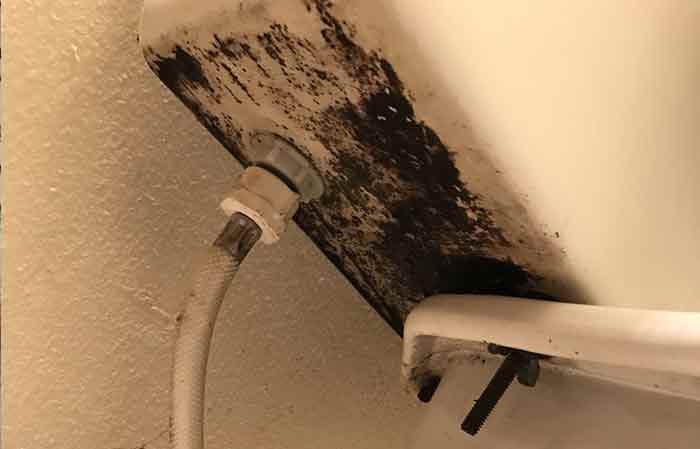
Black Mold/Spots in Toilet Bowl & Rim–How to get rid
In the bowl, black stains are usually found under the rim, below the waterline or at the base/bottom.
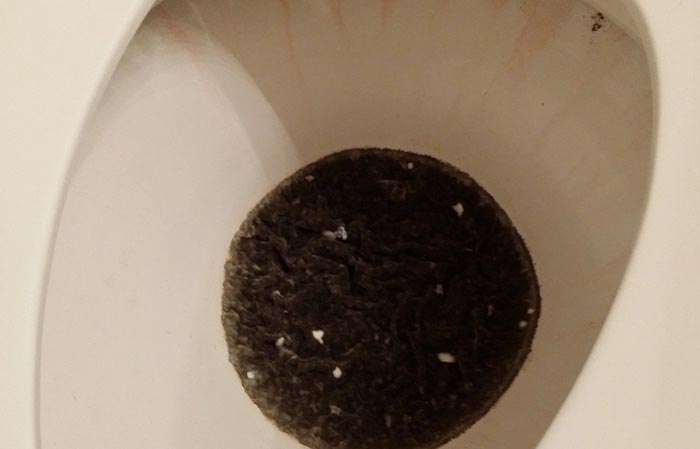
Mold forming at the water line can be an indication that you rarely use the toilet, your tank is infested with mold and it’s time for a thorough clean up.
When mold grows below the water line and more around the base of the toilet bowl, it could mean you have a broken water seal that needs immediate attention from the plumber. The broken seal means the area is experiencing a leak underneath or from the water inlet.
A leak then means a damp area and a conducive environment for the growth and development of mold. You have to replace the wax ring to stop the leak then clean the area to get rid of the mold.
Following are the steps to clean mold in the bowl
Required Items & Cleaners
- Protective Gear – gloves, goggles and a breathing mask(preferrably N-95 respirator, to prevent inhaling the airbone mold)
- Toilet Brush, Bucket Rags
- Cleaners and cleaning solutions-Brush, vinegar, bleach, baking soda or borax, steam cleaner
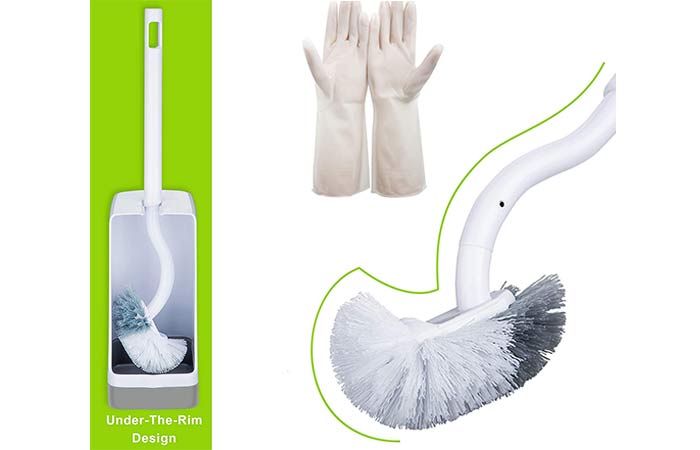
Vinegar Method(Natural)
- Open the door and windows of your bathroom to ensure the room is properly ventilated.
- Cover your hands with gloves and face with the mask and goggles
- Start off by flushing the toilet to remove all the water for a clear view of the mold spots at the water line and bottom of the bowl.
- For light mold spray vinegar inside the bowl and let it sit for 15-30 minutes.
- Scrub the mold until it comes off
- Flush to rinse and get rid of any remaining vinegar.
- Repeat 4, 5 & 6 a few times until all the mold is cleaned.
- Disinfect and clean up your cleaning items when done
Vinegar & Baking Soda Method
- Pour 1 cup of vinegar into the bowl
- Over the vinegar and water solution in the bowl, spray baking soda around the inside of the bowl. Do not forget the section under the bowl rim.
- Close the bowl lid and let the vinegar/baking soda sit in the toilet for about 30-60 minutes.
- Gently scrub with a toilet brush, old toothbrush or any other non-abrasive material to loosen and remove the mold stains. Ensure the brush gets all around the bowl including under the rim
- Let the toilet sit again for about 15 minutes
- Flush the toilet for a clean rinse
- If the mold is still not gone, repeat and scrub more.
Removing Mold in Toilet Bowl & Seat with a Steam Cleaner
This is a chemical-free way to do away with mold in your bathroom. All you need is an affordable multipurpose steamer like this that comes with 18 attachments!
- Empty the bowl
- Position the angle nozzle attachment on the hose.
- While in your protective gear, steam the toilet bowl water line, base and underneath the rim at high pressure to loosen the stains.
- After the bowl, target the steam on the hinges and the toilet seat edges to loosen any mold and rust on screws.
- Fill spray bottle with vinegar to wash off the loosened dirt into the toilet bowl.
- Flush the toilet.
After any of the two methods above you can also add a cup of bleach mixed with one gallon of water, into the toilet bowl and let it sit for 15-30 minutes. Bleach disinfects and does a thorough final cleaning. However, it is important to note that on its own, bleach does not completely kill mold.
If you want instantly kill the mold without scrubbing, you can try commercial mold cleaners like RMR Instant mold & Mildew Stain Remover or Clorox Tilex Spray
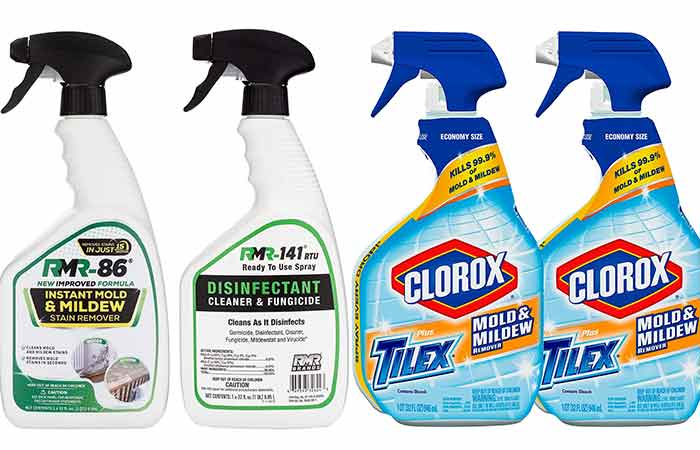
Recommended Reading: How to Clean Mineral Deposits, Dirt, and Black Stuff under Toilet Bowl Rim
Dealing with Black Mold in Toilet Tank
Once you’ve spotted the mold in the water tank, you need to clean out the tank thoroughly to stop it spreading to the bowl and other parts of your toilet. There are several ways you can do that, including using simple DIY ingredients such as vinegar or lemon juice mixed with baking soda.
Materials Needed
- Soft hand brush
- Vinegar
Method
- Pour distilled vinegar into the tank
- Let the vinegar and water solution sit for about 30 minutes.
- Flush a few times, scrubbing inside of the tank to remove any mold that may not have come out yet.
- Repeat until the mold is gone.
you can also add baking over the water and vinegar in the tank for an intense removal. It is vital to note that bleach and concentrated vinegar are corrosive and can affect some tank components. Avoid bleach and ensure the vinegar is distilled.
How to Remove Mold Behind Toilet Tank
When water drips at the back of the toilet tank, mold can grow there as well. Luckily, removing mold from behind the tank is simpler. Here’s how:
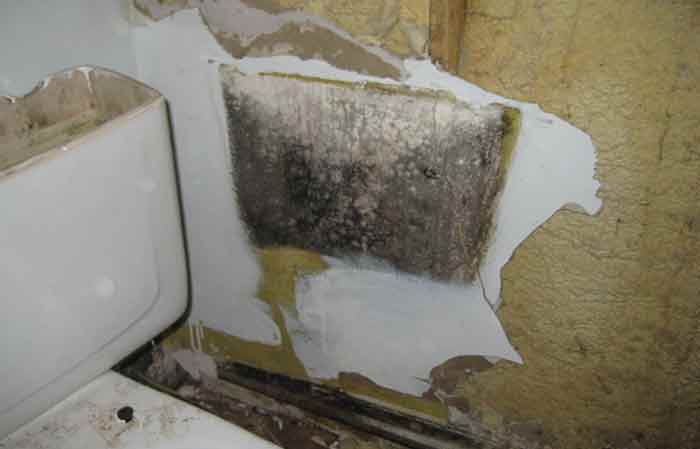
Materials Needed
- Bucket or container
- Rags
- Soft hand brush
- Vinegar
- Baking soda
- Disinfectant/ Bleach
Method
- Wipe down the back of the toilet tank to get a clear glimpse of where the mold is.
- Make a paste in a dish using baking soda and vinegar. Ensure the paste is thick enough to stick behind the toilet tank.
- Apply the paste over the mold-infested areas ensuring to cover each and every section of the back area.
- You can scrub gently with the hand brush to make sure the paste gets in between the grout areas of the tank.
- Leave it on for half an hour.
- Once back, scrub the back of the toilet gently to scrape off the mold that may not have come out yet.
- Wipe down with a rag to see any areas that may need further scrubbing. Continue until you have your results.
- Spray clean water on the area for a clean finish. You can also add some bleach to disinfect.
- If the mold spots or stains haven’t cleared, repeat until you achieve the results you want.
Why is there Black Stuff in Toilet after Flushing?
If you notice black stuff after flushing your toilet it means that either the pipes that supply water to your house have some rust or leaks. The leaks and rust harbor black mold that is then transferred to your toilet tank.
At the same time, black stuff could indicate an issue with the water itself. The water may be dirty, with mineral deposits or some unidentified residue that is black.
How to Prevent Mold Growing in Toilet & Bathroom
To avoid any further growth of mold, the following simple preventive measures can help.
- Ventilate the bathroom during and after you take a shower. Opening the windows or using an air conditioner keeps the area cool and dry, which then inhibits the growth of mold.
- Use dehumidifiers when you cannot open the windows such as at night or during cold seasons.
- Always clean up after using the toilet. Flushing down your waste even after using it for a short call.
- Regularly clean the toilet using scrubs and chlorinated cleaners.
- Fix any bathroom leaks as soon as you see them.
- Put some borax in the toilet to help prevent the growth of mildew and mold.
- Always remember to revisit the affected site(s) shortly after cleanup to check signs of water damage or mold growth.
- Cover cold surfaces, such as cold-water pipes, with insulation to prevent condensation
- Vent bathroom appliances that produce moisture, such as clothes dryers and heaters to reduce humidity.
- Before painting or caulking bathroom appliances or surfaces, ensure the surfaces are mold-free and dry. Paint and caulk do not kill or remove mold and paint applied over moldy surfaces is likely to peel.
If non of the above toilet bathroom mold cleaning methods and prevention measures seem to work, or if the situation looks like it is out of your control, you may want to consult a specialist who is experienced in cleaning indoor mold.
Black Mold in Toilet Bowl Diabetes
There’s no direct link between mold and diabetes. It, therefore, means mold doesn’t cause diabetes. However black mold could highlight certain symptoms of diabetes in your body.
Well, mold is known to thrive in sugar, when one is suffering from diabetes, the body doesn’t adequately hold on to enough glucose but rather releases it through urine.
Hence, when you notice a reoccurrence of mold in your toilet with all other factors constant, it could mean your urine contains too much sugar meaning you may be suffering from diabetes even without your knowledge.
The link then appears in that mold infestation could be a major indication of your blood sugar levels in sweat and urine, warranting the need for a checkup.
Is Toilet Mold Dangerous-Can it make you Sick?
The black mold growing in the tank, behind it, and under the toilet bowl can be a hazard to anyone, healthy or unhealthy. According to EPA and other health experts, exposure to mold can lead to a stuffy nose, wheezing, red or itchy eyes and skin, hay fever and shortness of breath.
It is worse, especially for individuals who are allergic to spores. It is recommended that you have safety measures put in place so as not to encourage its growth. You could put on a respirator so that the spores from the mold don’t trigger allergic reactions as you clean.
Further Reading
Hello my friend! I want to say that this post is amazing, nice written and include almost all vital infos. I would like to see more posts like this. Mariele Isadore Donny